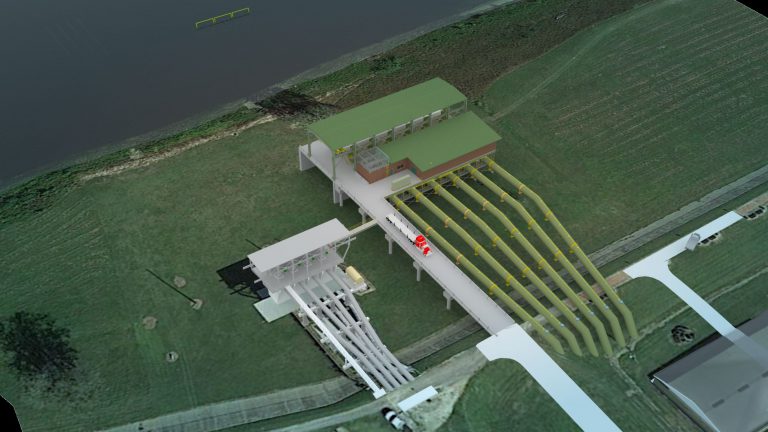
Missing toddler believed to be in imminent danger
December 27, 2021
Josiah LeCompte
December 27, 2021The Bayou Lafourche Freshwater District recently announced that they received the final U.S. Army Corps of Engineers (Corps) permitting to advance the Bayou Lafourche Mississippi River Re-Introduction and Pumping Capacity Improvement Project in Donaldsonville. The project has been a top priority of the Bayou Lafourche Freshwater District has an extensive history.
Bayou Lafourche Freshwater District Executive Director Ben Malbrough explained the project and how they are coming together alongside partners to further along with the project. Malbrough explained the Pump Capacity Improvement Project is just one of the components of the Bayou Lafourche Mississippi River Re-Introduction and Pumping Capacity Improvement Project. The program began as a concept in the late 80s and early 90s that has since then been developed to what it is today. Different resource agencies have picked up the project, moved it further along, and it was formalized into a defined program in 2006 when the department of natural resources finished what was referred to as the Mississippi Reintroduction to Bayou Lafourche Phase II project. Within that project, several major components add up to their ultimate goal: channel dredging, Union Pacific Railroad Bridge Replacement, water control structures, weir removal, and additional pump capacities.
Currently, Malbrough shared that Bayou Lafourche’s pumping capacity is about 450 cubic feet per second (CFS). The new station that is being designed and constructed initially has a minimum of 1,000 CFS with the ability to expand to 1,500 CFS. What does this mean? It will triple the capacity for freshwater entering the bayou. So why is it so important for freshwater to reach the bayou? It helps combat saltwater intrusion that has been detrimental to our coast and it also provides fresh drinking water to over 300,000 residents in Assumption, Ascension, Lafourche, and Terrebonne parishes; that’s nearly 10 percent of the state’s population!
A report was finalized for the projects in 2006 that had a price tag of almost $200 million. In 2006, there was limited funding available for coastal restoration and protection projects. It has since changed because of the BP oil spill and the onset of GOMESA. Malbrough said that 2008 was the breaking point of the freshwater district with the project when Hurricane Gustav caused the bayou to go septic. “They couldn’t treat it, they couldn’t get the smell out, and they had a boil water advisory for a substantial length of time. It was a bad deal,” he said. Although it was a bad situation, he said it was the “aha” moment for leaders to realize that something had to change and they needed to find ways to prevent it from happening again. It was right around that time that the Coastal Protection and Restoration Authority (CPRA) formed and was a game-changer in coastal restoration initiatives.
As a result of Hurricane Katrina, CPRA formed and stood up in 2007. Simply put, Malbrough explained the agency by saying they took the flood protection component from the DOTD and the coastal restoration component from The Department of Natural Resources and stood up as its own agency. CPRA was tasked with the first phase of channel dredging from Donaldsonville to Belle Rose, which he said is what got the work started. The $20 million dredging project was completed in 2011 and immediately following, the state made another $20 million available to keep the dredging going. From that point, he said it became the responsibility of the Bayou Lafourche Freshwater District to start moving the projects forward. “They have certainly have become our big brother on the funding side of things, without CPRA none of these projects that we are talking about would haven’t even had the chance to get off of the ground,” he said. They have continued the project and have done 12 miles of channel dredging that was completed at the beginning of 2016. With the same funding source, they were able to take care of the railroad bridge where they had a $5 million railroad reconstruction that removed the levee embankment and culverts to replace it with an open-span bridge so that water could flow freely under the bridge.
Another funding source that helped move the projects forward was the Coastal Impact Assistant Program (CIAP). During the Blanco administration, Federal legislation was passed that allowed offshore mineral and gas revenue to be shared between the Gulf states. The state, along with coastal parishes, received money through the program. “We were able to utilize some of the state’s money, or CIAP money, to do those projects,” Marlborough explained. CIAP projects had to be complete by December 31, 2016, which led to projects such as the weir removal in Thibodaux. There was a pump station rehab program in place that coupled with channel dredging, the railroad embankment removal, and the others that allowed them to now, for the first time in the freshwater district’s history, be able to pump at full capacity year-round, “we were always limited on how much water we could put into the bayou, because of water elevation, and now that has all been alleviated,” he said.
They have been pumping at full capacity year-round since the completion of the channel dredging and it has allowed them to focus on the remaining portions of the project which was a water control structure in Napoleonville that was completed last year. Once that was completed, they could stop and hold all water if they had any kind of reduction in the pumping scenario. That allowed them to move forward on removing the weir which was constructed in the 70s to be able to create a reservoir for the water intake facilities above it. When the Napoleanville structure was completed, it allowed the district to protect the water supply for Assumption and Ascension, it allowed them to remove the weir, because they had already relocated a water control structure in Lockport that can protect Lafourche, Terrebonne, and Thibodaux in the event there’s a reduction in the water supply. He said all of that happened which made it possible to move forward to “the crown jewel”: the new pump station.
The early works of the project were started with CIAP money in 2015-2016, and he said they have since then been working on design, permitting, and funding. In 2019, they were able to sign a cooperative endeavor agreement with CPRA and DEQ for the funding of the pump station and he said it’s a first of its kind when it comes to the funding mechanism. They are utilizing a $65 million loan from DEQ where the freshwater district is going to service $15 million of the debt, and then CPRA is going to cover $50 million of the debt. “Without CPRA, we’re not having these conversations. They not only have been very generous with the checkbook, but they have been huge supporters of our project from an engineering perspective, PR perspective, everything we have ever asked CPRA to do, they’ve been more than willing and happy, and have been a huge partner in this,” he said. There are other partners included such as Lafourche Parish Government who funded the weir removal and a portion of the water control structure relocation. Assumption Police Jury allocated a portion of their CIAP money to put towards the phase two-channel dredging which allowed them to dredge an additional four miles. He also said Congressmen Graves and Scalise have been huge supporters of the endeavors.
Since 2010 when the first shovel hit the ground, they have made about $140 million worth of improvements where nearly $25 million of it has come from the freshwater district. “A considerable amount comes from other agencies and other partnerships,” he said, “That’s why it’s really important to continuously work on those relationships with neighboring government agencies and private partners.”
This was all the pre-cursor that led up to the pump station project and couldn’t be done until the other projects were completed. He said the problem is that funding is still limited, although there is more now than there was before the Macondo Well incident, it’s still limited. He said they have to build a program like this in increments and phases, and there are some things we can’t do until another component is complete.
When they signed the funding agreement for the pump station, they were essentially complete with the design, so he said they could have theoretically gone out to bid in 2019 which he said would have been a big deal because the cost would have been much less than it will be now. However, because of the project’s proximity to the Mississippi River levee, it triggers a much more extensive permitting effort through the Army Corps of Engineers and that’s what they have been working through since the agreement was signed.
He announced they finally got the permit in October for the pump station and have since then been working on litigation requirements. Once they received the permit, it allowed them to then formally close the loan with DEQ and received the first disbursement of funding at the beginning of December. They are now working to go out to bid on construction. He said they are looking for a mid-March bid opening so hopefully, by May, they are turning dirt. He expects it to be a two-and-a-half to a three-year construction timeframe.
Once the pump station is completed, Marlborough said it still won’t be fully completed. Up to date, they have dredged as far as they can with their existing pump capacity. Currently, the further they dredge, the lower the water surface elevation falls. So far, they have dredged to Assumption High School in Napoleonville and cannot go any further until they have additional pump capacity. They are planning to break ground on the dredging as soon as they cut the ribbon for the new pump station. Dredging will be from Assumption High School to at least Percy Brown Bridge, or maybe a little further, which is about 15 miles of additional dredging that will need to be completed. He shared all of this in excitement because, after all of the years, this could possibly mean that the Mississippi River Reintroduction to Bayou Lafourche Project to be completed in 2025, which he says is a big deal.
So, what does this mean for the area? The freshwater district has two mandates; the first and foremost is to provide quality freshwater to the villages and municipalities that utilize it. Increasing the ability to pump more freshwater into Bayou Lafourche is critical not only for the drinking water supply, but also to push more freshwater down to lower Terrebonne and Lafourche to combat saltwater intrusion which is a major driver of the reintroduction project. He shared that the Eastern side of Terrebonne and the Western side of Lafourche, between Pointe aux Chenes and Larose, have some of the highest land-loss rates on the globe, and he said a lot of it has to do with the lack of proximity to the Mississippi River and the Atchafalaya River. In other words, it’s the farthest from the rivers which means it’s not replenished with a steady reliable source of fresh water and nutrients. Everything the Bayou Lafourche Freshwater District has been done to preserve the valuable natural resource that is Bayou Lafourche and keep the water flowing for generations to come.







